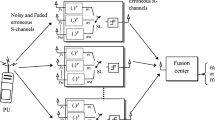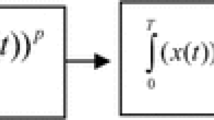Abstract
In this paper, the impact of a multi slot based cooperative spectrum sensing (CSS) on the performance of a cognitive radio (CR) network has been investigated. Each CR user, equipped with an improved energy detector (IED), uses a number of mini slots of the sensing time to perform the spectrum sensing. Each CR uses OR logic to combine the sub local decisions generated in each mini slot to obtain a local decision at CR level. Local decisions are sent to fusion centre (FC) over reporting channel. The FC obtains a final decision about the presence of primary user (PU) by combining the local decisions using a fusion rule: Majority or Maximal Ratio Combining. The performance of the CSS is assessed in terms of detection probability and false alarm probability considering both the sensing and reporting channels are Rayleigh faded. Furthermore, the impact of a number of sensing slots and IED parameter on throughput of CR network is also evaluated under the proposed spectrum sensing scenario. Impacts of several sensing parameters such as sensing channel SNR and reporting channel SNR on the performance of CR network are also evaluated. Performances of two fusion rules under study are compared. Effect of sensing error and synchronisation error is indicated. Further the study is extended for independent but non identically distributed (i.n.i.d.) Rayleigh faded channels as well as for a multiple PU scenario also.












Similar content being viewed by others
References
Federal Communication Commission. (2002). Spectrum Policy Task Force. Rep. ET Docket No. 02-135.
McHenry, M. A. (2005). NSF spectrum occupancy measurements project summary. Company Report (online). http://www.sharedspectrum.com.
Mitola, J., & Maguire, G. Q. (1999). Cognitive radio: Making software radios more personal. IEEE Personal Communications, 6(4), 13–18.
Weiss, T. A., Jondral, F., & Mar, K. (2004). Spectrum pooling: An innovative strategy for the enhancement of spectrum efficiency. IEEE Communications Magazine, 42(3), S8–14.
Digham, F. F., Alouini, M. S., & Simon, M. K. (2003). On the energy detection of unknown signals over fading channels. In Proceedings of IEEE International Conference on Communications (pp. 3575–3579).
Singh, A., Bhatnagar, M. R., & Mallik, R. K. (2011). Cooperative spectrum sensing with an improved energy detector in cognitive radio network. In Proceedings of NCC 2011. Indian Institute of Science, Bangalore.
Ying-Chang, L., Yonghong, Z., Peh, C. Y., & Hoang, A. T. (2008). Sensing-throughput tradeoff for cognitive radio network. IEEE Transactions on Wireless Communications, 7(4), 1326–1337.
Ghasemi, A., & Sousa, E. S. (2005). Collaborative spectrum sensing for opportunistic access in fading environments. In Proceedings of 1st IEEE Symposium New Frontiers in Dynamic Spectrum Access Networks (pp. 131–136). Baltimore, USA.
Digham, F. F., Alouini, M. S., & Simon, M. K. (2007). On the energy detection of unknown signals over fading channels. IEEE Transactions on Communications, 55(1), 21–24.
Ding, J., Guo, J., Qu, D., & Jiang, T. (2014). Novel multiple slots energy detection for spectrum sensing in cognitive radio networks. In 15th Asia-Pacific Conference on Communications (pp. 81–84).
Umashankar, G., & Kannu, P. (2013). Throughput optimal multi slot sensing procedure for a cognitive radio. IEEE Communications Letters, 17(12), 2292–2295.
Dafei, S., Song, T., Wu, M., Hu, J., Guo, J., & Gu, B. (2013). Optimal sensing time of soft decision cooperative spectrum sensing in cognitive radio networks. In Wireless Communications and Networking Conference (WCNC) (pp. 4124–4128). IEEE.
Nallagonda, S., Roy, S. D., Kundu, S., Ferrari, G., & Raheli, R. (2013). Cooperative spectrum sensing with censoring of cognitive radios in Rayleigh fading under majority logic fusion. In Proceedings of IEEE Nineteenth National conference on Communications (NCC) (pp. 1–5), IIT Delhi, India.
Guo, J., Zhong, G., Qu, D., & Jiang, T. (2009). Multi-slot spectrum sensing with backward SPRT in cognitive radio networks. In Proceedings of Wireless Communications and Signal Processing (pp. 1–5).
Haewoon, N., Ko, Y.-C., & Baxter, F. (2006). Performance analysis of OT-MRC over IID Nakagami and non-IID Rayleigh fading channels. IEEE Transactions on Vehicular Technology, 55(6), 1941–1946.
Krithiga, S., & Bhaskar, V. (2013). Performance analysis of independent and non-identically distributed \(\alpha {-}\mu\) fading channel under absolute SNR scheduling. In ICCN 2013 (pp. 169–179). Elsevier.
Boulogeorgos, A.-A. A., Chatzidiamantis, N. D., Karagiannidis, G. K., & ZuoYu, Y. (2016). Spectrum sensing with multiple primary users over fading channels. IEEE Communications Letters, 20(7), 1457–1460.
Antonio, F., Irio, L., Oliveira, R., Bernardo, L., & Dinis, R. (2016). Spectrum sensing performance in cognitive radio networks with multiple primary users. IEEE Transactions on Vehicular Technology, 65(3), 1564–1574.
Si, J. B., Li, Z., Yang, D., & Yan, Z. Y. (2015). Parallel cooperative sensing in multichannel cognitive radio networks with partial CSI. In Proceedings of Wireless Communications and Signal Processing (pp. 1–6). IEEE.
Ahmadi, H. R., & Vosoughi, A., (2008). Impact of channel estimation error on decentralized detection in bandwidth constrained wireless sensor networks. In Proceedings of IEEE MILCOM (pp. 1–7). San Diego, CA.
Li, L., Zhou, X., Xu, H., Li, G. Y., Wang, D., & Soong, A. (2011). Energy efficient transmission in cognitive radio networks. IEEE Transactions on Broadcasting, 57(3), 718–720.
Zhiping, S., Kah, C. T., & Kwok, H. L. (2013). Energy efficient joint design of sensing and transmission durations for protection of primary user in cognitive radio systems. IEEE Communications Letters, 17(3), 565–568.
Yunfei, C. (2010). Improved energy detector for random signals in Gaussian noise. IEEE Transactions on Wireless Communications, 9(2), 558–563.
Nallagonda, S., Roy, S. D., & Kundu, S. (2013). Performance evaluation of cooperative spectrum sensing scheme with censoring of cognitive radios in Rayleigh fading channel. Wireless Personal Communications, 70(4), 1409–1424.
Bhowmick, A., Roy, S. D., & Kundu, S. (2015). Sensing throughput trade-off for an energy efficient cognitive radio network under faded sensing and reporting channel. IJCS. doi:10.1002/dac.3087.
Author information
Authors and Affiliations
Corresponding author
Appendix
Appendix
Proof of (19)
where \(P(y_{i, FC}\ge \lambda _{FC}|D_i=1)\) and \(P(y_{i, FC}\ge \lambda _{FC}|D_i=0)\) are the detection probabilities at FC and can be represented as \(P(y_{i, FC}\ge \lambda _{FC}|D_i=1)= P_{d,FC}^{1}\) and \(P(y_{i, FC}\ge \lambda _{FC}|D_i=0)= P_{d,FC}^{0}\) respectively as in [25],
whereas \(P(D_i=1|H_1)\) and \(P(D_i=0|H_1)\) are the detection probabilities at CR level which can be represented as \(P(D_i=1|H_1)= P_d^l = (1-[1-P_{d(i,j)}^F]^M)\) and \(P(D_i=0|H_1)=1- P_d^l = (P_{d(i,j)}^F)^M\) respectively. Thus (35) can be written as,
Proof of (20) :
The detection probabilities \(P(y_{i, FC}\ge \lambda _{FC}|D_i=1)\) and \(P(y_{i, FC}\ge \lambda _{FC}|D_i=0)\) are given in the proof of (19). Whereas \(P(D_i=1|H_0)\) and \(P(D_i=0|H_0)\) are the false alarm probabilities at CR level can be represented as \(P(D_i=1|H_0)= P_f^l = (1-[1-P_{f(i,j)}^F]^M)\) and \(P(D_i=0|H_0)=1- P_f^l = (P_{f(i,j)}^F)^M\) respectively. Thus (37) can be written as,
Rights and permissions
About this article
Cite this article
Bhowmick, A., Yadav, K., Roy, S.D. et al. Multi slot-throughput tradeoff in an improved energy detector based faded cognitive radio network. Wireless Netw 24, 2539–2552 (2018). https://doi.org/10.1007/s11276-017-1487-0
Published:
Issue Date:
DOI: https://doi.org/10.1007/s11276-017-1487-0




